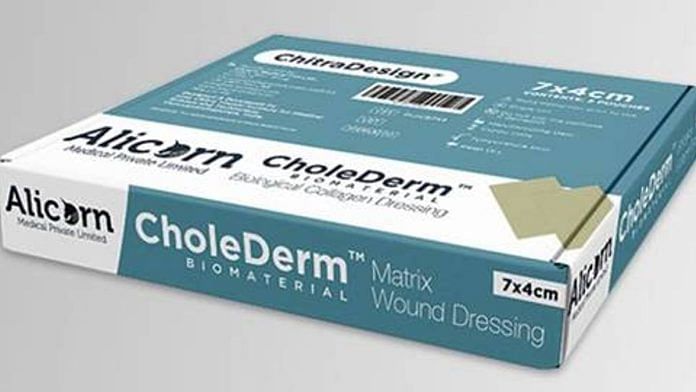New Delhi: An Indian institute has for the first time developed a low-cost biomedical device that uses tissue from the pig gall bladder to rapidly heal skin wounds — the kind where the skin itself is destroyed and grafts are required, like burns — and leave behind few scars.
The tissue-engineering scaffold, called Cholederm, was developed by Sree Chitra Tirunal Institute for Medical Sciences and Technology (SCTIMST), a Thiruvananthapuram-based autonomous institution of the Department of Science and Technology (DST).
The biomedical device satisfies all statutory requirements of the Central Drugs Standard Control Organisation and has been approved by the Drugs Controller General of India (DCGI), the DST said in a statement Tuesday.
While the technology behind the device is not new, the DST pointed out that so far there has been no good quality, indigenously-developed product for skin wounds.
The SCTIMST team, led by T.V. Anilkumar and consisting of researchers from the experimental pathology division in the Biomedical Technology Wing of the institute, had been conducting investigations in this field for the past 15 years.
“Considering the stringency of the compliance requirements for Class D Medical Devices [high-risk medical devices] as per the 2017 Medical Device Rules of India and the general belief among stakeholders that development of animal-derived Class-D Medical Devices is not practical in India, this is a milestone achievement for the institute, especially the research team as well as Alicorn Medical,” Dr Harikrishna Varma, the head of SCTIMST’s Biomedical Technology Wing, said in a statement.
In 2017, the technology behind the device was transferred to Alicorn Medical, a Kerala-based biopharmaceutical startup in the technology incubation facility (TIMed) of the SCTIMST.
The Cholederm research team expects that, with the introduction of the device in the Indian market, treatment cost for skin wounds can be reduced to Rs 2,000 from Rs 10,000. Since the technology is new, the researchers see potential for the product in the international market as well.
Also Read: Don’t fall for extensive skin care during winter. Fix dryness, dullness with these steps
Technology & limitations
The SCTIMST research team prepared the tissue-engineering scaffold — implants or injectables used to deliver cells, drugs, and genes into the body — by recovering the extracellular matrix from the gall bladder of pigs.
As part of their previous research, the team had discovered the mechanism of the skin-healing reaction, and showed that anti-inflammatory specialised cells involved in the immune system that destroy bacteria and other pathogens also played a major role in healing when skin grafts were used.
Using these findings, the team was able to develop a scaffold that mitigated the scarring reactions in subcutaneous, skeletal muscle, and cardiac tissues.
Their experiments found that the device, Cholederm, healed different types of skin wounds, including burn and diabetic wounds in rats, rabbits, and dogs, faster than similar products currently available in the market.
The scaffold further reduced scarring and mitigated internal scarring in rats suffering an experimental myocardial infarction.
The technology, the researchers say, also turns the gall bladder of pigs — normally worthless slaughterhouse waste — into a high-value raw material for the biopharmaceutical industry, creating an additional income-generating opportunity for pig farmers.
However, there are a few limitations to the technology. Using the scaffold to treat cardiac injury in humans would be cumbersome, the team says.
The team is thus working on developing an injectable gel formulation of the scaffold that permits transvenous on-site delivery.
(Edited by Nida Fatima Siddiqui)
Also Read: Do you have a sweet tooth? This is what sugar does to your skin



